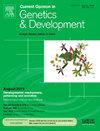NOVA1/2基因与神经发育中的选择性剪接
IF 3.6
2区 生物学
Q2 CELL BIOLOGY
引用次数: 0
摘要
NOVA1和NOVA2是选择性剪接(AS)所必需的神经元特异性rna结合蛋白,通过调节转录物多样性影响神经发育。这些蛋白识别前mrna上的YCAY序列,调节外显子包含或跳跃,内含子保留和选择性聚腺苷化。尽管NOVA1和NOVA2的序列具有75%的同源性,但它们表现出不同的时空表达模式和靶向特异性,其中NOVA2主要表达于皮质区,而NOVA1主要表达于小脑和脊髓。NOVA2的从头截断变异可导致严重的神经发育障碍(NDD),其特征是智力发育障碍、运动迟缓、自闭症特征和胼胝体发育不全。动物模型中Nova2的缺失会导致大脑发育异常,如小鼠的胼胝体发育,这反映了人类神经发育表型。如果直接证据仍然有限,新出现的数据表明NOVA1的突变也可能与神经系统疾病有关。其他mrna结合蛋白对NDD的贡献进一步强调了RNA加工调控在神经发育中的关键作用。本文综述了NOVA蛋白的多种功能,它们在大脑发育过程中对AS的影响,以及它们在大脑疾病中的意义。本文章由计算机程序翻译,如有差异,请以英文原文为准。
NOVA1/2 genes and alternative splicing in neurodevelopment
NOVA1 and NOVA2 are neuron-specific RNA-binding proteins essential for alternative splicing (AS), influencing neurodevelopment by regulating transcript diversity. These proteins recognize YCAY sequences on pre-mRNA, regulating exon inclusion or skipping, intron retention, and alternative polyadenylation. Despite their 75% sequence identity, NOVA1 and NOVA2 exhibit distinct spatiotemporal expression patterns and target specificities, with NOVA2 predominantly expressed in cortical regions and NOVA1 in the cerebellum and spinal cord. De novo truncating variants in NOVA2 are responsible for a severe neurodevelopmental disorder (NDD), characterized by intellectual developmental disorder, motor delay, autistic features, and corpus callosum hypoplasia. Loss of Nova2 in animal models results in brain development anomalies, such as corpus callosum agenesis in mice, which mirrors the human neurodevelopmental phenotype. If direct evidence remains limited, emerging data suggest that mutations in NOVA1 might also be involved in neurological disorders. The contribution of other mRNA-binding proteins to NDD further underscores the critical role of regulation of RNA processing in neurodevelopment. This review explores the diverse functions of NOVA proteins, their impact on AS during brain development, and their implications in brain disorders.
求助全文
通过发布文献求助,成功后即可免费获取论文全文。
去求助
来源期刊
CiteScore
7.90
自引率
0.00%
发文量
102
审稿时长
1 months
期刊介绍:
Current Opinion in Genetics and Development aims to stimulate scientifically grounded, interdisciplinary, multi-scale debate and exchange of ideas. It contains polished, concise and timely reviews and opinions, with particular emphasis on those articles published in the past two years. In addition to describing recent trends, the authors are encouraged to give their subjective opinion of the topics discussed.
In Current Opinion in Genetics and Development we help the reader by providing in a systematic manner:
1. The views of experts on current advances in their field in a clear and readable form.
2. Evaluations of the most interesting papers, annotated by experts, from the great wealth of original publications.[...]
The subject of Genetics and Development is divided into six themed sections, each of which is reviewed once a year:
• Cancer Genomics
• Genome Architecture and Expression
• Molecular and genetic basis of disease
• Developmental mechanisms, patterning and evolution
• Cell reprogramming, regeneration and repair
• Genetics of Human Origin / Evolutionary genetics (alternate years)

 求助内容:
求助内容: 应助结果提醒方式:
应助结果提醒方式:


